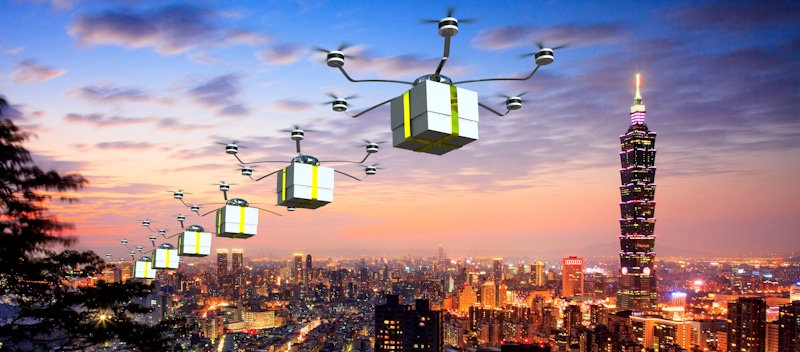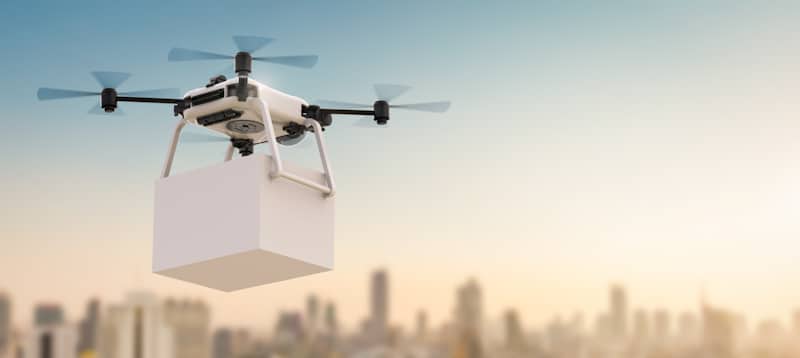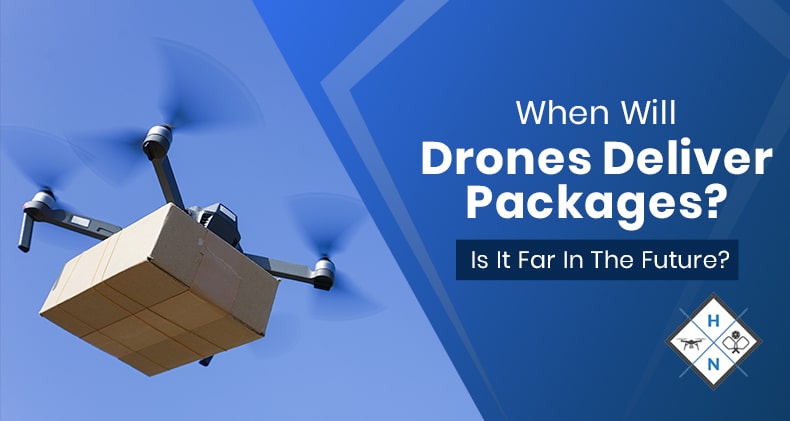Drones are growing in popularity today. You'll find them being used by hobbyists and a variety of commercial industries too. You may have even heard it being discussed that drones could start delivering packages.
Some estimate that by 2040 we'll see drones making same-day deliveries for businesses. Both Amazon and UPS are already testing this technology to see how it'll work for them. They agree that it won't be too long from now before we see drones delivering packages to people.
Issues with Drone Delivery
Before drone delivery can become a thing there are three important issues that must be ironed out.

FAA’s Part 107 Drone Regulations
Part 107 drone regulations were put into effect by the FAA (Federal Aviation Administration) on August 29, 2016. According to this regulation, drones can't be used for air transportation. There are several reasons for this, including:
- Fully autonomous drones aren't legal since a pilot is required to be in command of the drone at all times.
- Unless a pilot gets a waiver they're only permitted to fly one drone at a time. This means that without a waiver a swarm of drones can't be implemented. This is important to understand because releasing a swarm of drones would make it much more efficient to use drones for delivering packages.
- You can't operate a drone from a moving vehicle. They also can't be operated over any other moving vehicle. This is challenging since vehicles are always moving around in residential areas and cities. While you may consider flying at night so your drone doesn't encounter this issue, you'll need a waiver. Of course, either way, you'll need a waiver.
- Drones can't be operated in Class B, C, D, or E at the surface airspace if you don't have a waiver.
- Pilots can only operate drones within their line of sight. Unfortunately, due to a drone's size, you can only see them out to a certain distance. This means for a drone with a 14-inch cross-section you can only operate it at a distance of 4,010 feet. To reach customers you'll probably need to fly beyond this point.
FAA’s Section 44807 Exemption for Commercial Drone Operations
Since Part 107 doesn't allow BVLOS (Beyond Visual Line of Sight) drone delivery some companies are choosing to fly their drones under Part 91. This states that aircraft must be deemed airworthy in order to fly. Unfortunately, there aren't any drones that have been certified airworthy.
The only way to circumvent this is for the operator to obtain a Section 44807 exemption from DOT (the Department of Transportation). They're the only ones who can say that a drone doesn't need this certificate. To obtain this from DOT takes a lot of time and paperwork.
Additionally, it's important to understand that Section 44807 is only for the aircraft itself. This means you'll still need an exemption from Part 135 to be able to carry people's packages. Although this is difficult to obtain, Google's Wing Aviation, LLC has managed to obtain it for one of their pilots but this is only for one person. Another company that's obtained this exemption is UPS. Unlike Google, UPS hasn't been given any limits regarding the size and scope of its operations. Nevertheless, these companies must still address what to do about the Airline Deregulation Act 49 U.S.C. § 41713(b)(1) which states that two states may not come together to regulate the price, route, or service that an air carrier can take. While it is possible to get a waiver here as well, this is just another example of all the red tape that these businesses are going through in order to be able to use drones to deliver their products to people.
Other Drone Regulations
As the number of drones increases, the number of laws in effect throughout the United States seems to also be increasing. Today drone pilots find themselves being governed by the Federal Aviation Regulations as well as regulations from the state, county, city, town, village, and borough. While it's relatively easy to see what a state's laws are regarding drones, it's a bit trickier to understand the other laws that apply to drone flight.
Not only do drone laws differ depending on where you're located, but local governments use a wide array of terms when referring to the same thing (e.g. unmanned aircraft, drone, model aircraft). With so many gray areas most companies are going to need a drone regulatory compliance department which is something that could actually be more of a drain on the business than actual help.
Advantages to Drone Delivery Service
There are a lot of rules and regulations businesses must abide by if they want to use drones to deliver packages. Unfortunately, this has resulted in a lot of red-tape that's turned into drawbacks when it comes to making headway for any of these services. However, before completely ruling out drone delivery service you should take the advantages of this service into consideration.

Drones will improve time management
When drones are used to deliver packages it frees people up to do other important jobs. This is because drones are faster and more accurate. Their margin of error is actually quite small.
Drones can conserve energy
People don't need to exert as much energy when using drones for delivery. Drones are actually able to accomplish more tasks since they won't become exhausted. This is why they're being used to replace some human activities today.
Drones can save time
Businesses using drone delivery have additional manpower available. This means that employees will have more time to do other important jobs.
Drones actually promote safety
When drones are used it's less likely that an accident will occur since people will no longer find themselves being exposed to hazardous conditions.
Case Study: Amazon Prime Air Delivery Service
In August 2020 Amazon received permission from the federal government to start operating its drone delivery service under Part 135 of FAA regulations. This certification also allows Amazon to carry property on their small drones BVLOS. With these waivers and certifications in place, Amazon is set to start testing its drone delivery system. They've admitted that it took them a lot of hard work to obtain these waivers and say that they'll continue working with the FAA and other regulators throughout the world.
Amazon admits that they're not quite ready to deploy package deliveries on a large scale yet. However, they've started investing money into making this a reality in the not too distant future. Since then they've worked to create a new electronic drone that can carry packages weighing up to 5 pounds to customers up to 15 miles away in as little as 30 minutes.
How Prime Air Will Work
With Amazon Prime Air you'll receive packages weighing up to 5 lbs. in 30 minutes or less.
Although excited about this new service, Amazon says they won't launch Prime Air until it's safe to do so. Until then they're devoted to drying different vehicle designs and delivery mechanisms to see how they work and what the best options are for this service. This is something they're doing in the United States, the United Kingdom, Austria, France, and Israel. They're also working with regulators to design an air traffic management system that'll recognize drones and where they're flying to ensure that they abide by all operating requirements. Amazon says that safety is their number one priority so they'll continue testing advanced technologies to use for building their drones.
UPS to Follow Amazon's Foot Steps
UPS has also received their Part 135 Standard certification and their Part 107 waiver from the FAA. This has enabled them to also enter the drone delivery market and start scaling their business here appropriately.
What makes UPS so competitive and noteworthy in comparison to Amazon is the version of the Part 135 certification they received. While Amazon only received single-pilot certification and they're not permitted to fly a drone BVLOS UPS received the highest level of certification. This means that they're allowed to use as many pilots as they want and fly BVLOS. Additionally, UPS is allowed to operate their drones over the top of populated areas, fly at night, and carry cargo weighing over 55 pounds – all things that Amazon has yet to be permitted to do.

Conclusion
People from around the world are watching to see who will dominate the drone delivery airspace first. Investors should be watching as progress is made here and as both Amazon and UPS vie for the highest possible level of certification from the FAA. One thing that UPS does have working to its advantage here is its ability to easily scale its operations.
With all the movement in these industries today many people find themselves wondering when we'll see drones being used to deliver packages. This is something that both Amazon and UPS are already investigating. Many people are speculating that by 2040 drones will be used to make same-day deliveries for businesses like these but whether this is true is something we'll have to wait and see.
Also read: Drone Jobs – Start Your Drone Pilot Career and Earn Money!
Shawn Manaher loves to play with new toys and dive into new hobbies. As a serial entrepreneur, work definitely comes first but there is always room for hobbies.

